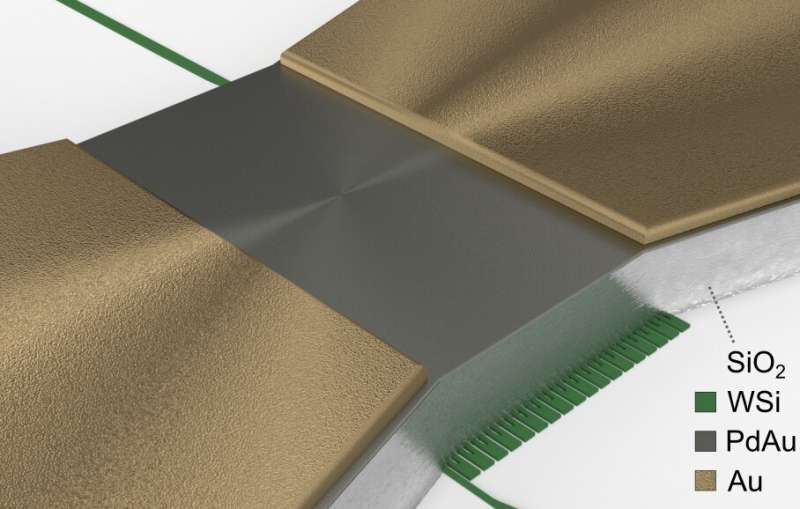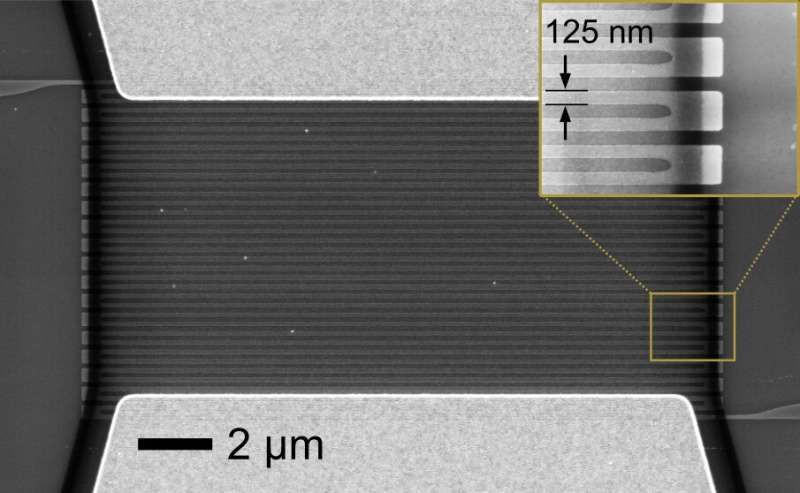October 7, 2019 feature
A superconducting switch for interfacing superconductors and semiconductors

Many existing techniques for developing quantum and neuromorphic computing tools are based on the use of superconductors, substances that become superconducting at low temperatures. In the same architectures, semiconductors, substances with a partial conductivity, are usually used to achieve top-level control. To work more efficiently, therefore, quantum and neuromorphic systems would require a low-power superconductor/semiconductor interface that has not yet been developed.
Researchers at the National Institute of Standards and Technology in Boulder, NASA's Jet Propulsion Lab and Lancaster University in the U.K. have recently realized a superconducting thermal switch that can translate low-voltage inputs into semiconductor-compatible outputs at Kelvin-scale temperatures. In their paper, published in Nature Electronics, the researchers demonstrated its potential for interfacing superconductors and semiconductors, using it to drive a light-emitting diode in a photonic integrated circuit.
"In our research, we're trying to build hardware neurons that will be massively scalable," Adam McCaughan, one of the researchers who carried out the study, told TechXplore. "In order to build a brain-scale neuromorphic computer, you need to have trillions of neurons and quintillions of connections—that means you have to be extremely energy-efficient and have lots of communication between the neurons. That's why we chose to combine superconductors and optoelectronics to build the neurons."
In their study, McCaughan and his colleagues combined superconductors with optoelectronics, a type of technology that uses both electronics and light. The superconductors they used are ultra energy-efficient, while the optoelectronics allow individual neurons to communicate with thousands of their peers. Merging these two technologies, however, proved incredibly challenging.
"Part of the reason superconductors are so energy-efficient is that they use very small signals, about 1/1000 the voltage needed in silicon," McCaughan said. "But that same efficiency also means they have trouble talking with silicon optoelectronics, so we needed to find a way of translating the superconducting outputs into silicon-level inputs."
The superconducting switch designed by McCaughan and his colleagues leverages the superconductor's transformation from one state of matter to another, known as 'phase transition,' to translate low-level inputs into silicon-compatible outputs. The switch's main component is a nanoscale superconducting nanowire with two 'phases' or 'states': the quantum superconducting phase and the resistive phase.

"When we turn on the switch, we generate heat in the form of phonons," McCaughan explained. "This heat destroys the superconducting phase and forces the wire into the resistive phase. Practically, what this means is that when we turn on the switch, the nanowire goes from zero resistance to a very large resistance, similar to a light switch in your home, but at the nanoscale, and at a few degrees above absolute zero."
In their study, the researchers used the superconducting thermal switch to drive a light-emitting diode in a photonic integrated circuit. They were able to generate photons at 1 K from a low-voltage input, while detecting them with an on-chip superconducting single-photon detector.
The switch they developed is the first ever superconducting device capable of producing such a huge change on demand, while also interfacing superconductors and semiconductors. Remarkably, it is also very energy-efficient, thus it uses far less energy than other existing devices.
"For our neuromorphic work, the development of this device means that the superconducting parts of our neurons can now talk directly to the optoelectronic parts," McCaughan explained. "As we showed in our paper, we can use it to do very useful things, such as powering optical communication at one degree above absolute zero. We're very excited to see how others make use of this idea."
In the future, this superconducting switch could pave the way for the development of more advanced quantum computers, as many of these systems will require the integration of superconducting devices with silicon control circuitry. McCaughan and his colleagues are now planning to implement their device on neurons to test its effectiveness and observe the resulting interactions between individual neurons.
"Spiking neurons like the ones in the brain and the ones we're building are commonly said to be the next generation of device for artificial intelligence, but training them is not as well understood as it is for the current generation of deep learning systems," McCaughan said. "We've been collaborating with TENNLab at the University of Tennessee to optimize networks of our neurons, and it's very exciting to see how just a small handful of our spiking neurons can solve tasks like pole balancing and data classification."
More information: A. N. McCaughan et al. A superconducting thermal switch with ultrahigh impedance for interfacing superconductors to semiconductors, Nature Electronics (2019). DOI: 10.1038/s41928-019-0300-8
© 2019 Science X Network



















